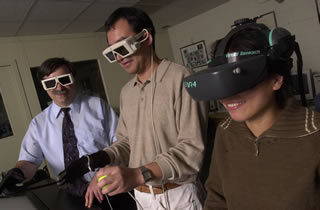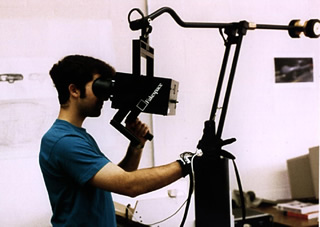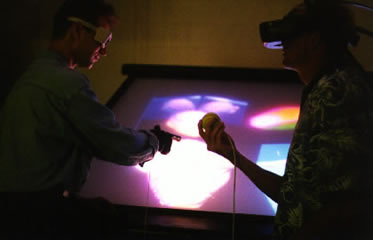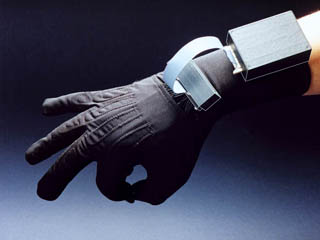
The term 'Virtual Reality' (VR) was initially coined by Jaron Lanier, founder of VPL Research (1989). Other related terms include 'Artificial Reality' (Myron Krueger, 1970s), 'Cyberspace' (William Gibson, 1984), and, more recently, 'Virtual Worlds' and 'Virtual Environments' (1990s).
Virtual Reality (VR) research and development is a rapidly evolving field. New display technologies and interaction devices are continually being produced and modified, redefining the way in which participants view, navigate and interact within Virtual Environments (VEs). Virtual Reality (VR) is an all-encompassing term which describes the technology and the field of application in general, but essentially VR replaces the real world with a synthetic computer generated environment. VR is an interface which combines diverse technical systems with the goal of enabling users to interact in real time within Virtual Environments (VEs). VEs are three-dimensional computer-based environments representing applications for visualization, animation, generation or modification of real or abstract objects/ situations.
Benefits of VR:
Technology Description:
As technology advances, it is difficult to talk about a singular 'VR system' as modern systems are made up of a number of different components depending on the user requirements for specific VR applications. A typical VR system consists of at least the following components:
Common VE Systems:
Desktop system
A typical desktop system uses a standard CRT monitor (or LCD laptop screen)
as the display device. The participant is not enveloped in the VE but has a
'window'
into the VE. Interactivity and navigation are achieved either via advanced
PC input devices such as the Spacemouse or multi-axis joysticks. Alternatively
the
VE interface can be designed to incorporate icons that allow the participant
to navigate or interact in the VE using standard PC input devices (mouse,
standard joystick or keyboard etc). Specialised software packages allow
VEs to be created and run on desktop PCs.
The Virtual Colonoscopy project allows doctors to visualize MRI data to check a patient's colon for polyps.
HMD System
A typical Head Mounted Display (HMD) consists of a helmet with two small
displays (CRT or LCD) and an adjustable lens system. HMDs are the first
projection systems
which have been developed specifically for viewing VEs. They can produce
stereoscopic viewing by presenting separate overlapping images to each
eye. They are widely
used for military and medical applications. They
vary in cost, and some devices can be desirable and affordable for home users
as display devices for 3D games. Interaction and navigation are achieved
through specialised input devices, for example 3D mice, wands or data gloves.
The HMD and the input devices are tracked in real-time using an electromagnetic
tracking system which is transformed by the computer to update the participant's
position within the VE. HMD systems are usually used by single participants,
however it is sometimes possible for multiple participants to inhabit the
same virtual environment.

On the right, a head mounted display.
BOOM
The BOOM (Binocular Omni-Orientation Monitor) from Fakespace is a head-coupled
stereoscopic display device. Screens and optical system are housed in a box
that is attached to a multi-link arm. The user looks into the box through
two holes, sees the virtual world, and can guide the box to any position
within the operational volume of the device. Head tracking is accomplished
via sensors in the links of the arm that holds the box.

Projection system (power wall, holobench, L-shaped systems,
etc)
In a typical projection system, the VE is projected onto a free-standing
or wall-mounted projection screen via conventional three-tube video projectors.
The VE can be viewed by a number of participants at any one time, depending
on the size of the projection screen and the space available.
The VE is usually manipulated and interacted with by one participant with
the remaining individuals as passive observers. Navigation and interaction
typically takes place using standard PC input devices, however more sophisticated
devices can be used. There are many types
of systems
that come under the generic heading of projection systems, these are generally
classified according to the display type.
 |
 |
The Center for Visual Computing's Virtual Workbench.
CAVE
2 - 6 walls (fabric or plastics) form a projection area or room (CAVE). CAVE
systems consist of two or more walls and a walkable floor all with rear projection.
Compared with a power wall the floor and additional walls extend the interaction
volume and therefore the sense of immersion. In particular a 6-sided CAVE requires
wireless tracking, interaction and sound devices. In contrast to dome-like
or curved screen systems, the flat walls guarantee a defined undisturbed
projection. Reconfigurable systems combine the advantages of different projection
systems.
They can be more or less easily adjusted to meet application specific requirements.
Input
Devices:
A variety of input devices like data gloves, joysticks, and hand-held wands
allow the user to navigate through a virtual environment and to interact
with virtual objects. Directional sound, tactile and force feedback devices,
voice recognition and other technologies are being employed to enrich the
immersive experience.

5DT data glove.
Immersive Virtual Reality:
Head-referenced viewing provides a natural interface for the navigation in
three-dimensional space and allows for look-around, walk-around, and fly-through
capabilities in virtual environments.
Stereoscopic viewing enhances the perception of depth and the sense of space.
The virtual world is presented in full scale and relates properly to the human size.
Realistic interactions with virtual objects via data glove and similar devices allow for manipulation, operation, and control of virtual worlds.
The convincing illusion of being fully immersed in an artificial world can be enhanced by auditory, haptic, and other non-visual technologies.
Non-immersive VR:
These applications include mouse-controlled navigation
through a three-dimensional environment on a graphics monitor, stereo viewing
from the monitor via stereo glasses, stereo projection systems, and others.
Apple's QuickTime VR, for example, uses photographs for the modeling of
three-dimensional worlds and provides pseudo look-around and walk-through
capabilities on a graphics
monitor.
QTVR view of the Student Activities Center.
An anaglyph QuickTime VR object. Requires red/blue glasses to view properly.
VRML:
VRML provides three-dimensional worlds with integrated hyperlinks on the
Web. The viewing of VRML models via a VRML plug-in
for Web browsers is usually done on a graphics monitor under mouse-control
and,
therefore, is not fully immersive. However, the syntax and data structure
of VRML provide an excellent tool for the modeling of three-dimensional
worlds
that
are functional and interactive and that can, ultimately, be transferred
into fully immersive viewing systems. The current version VRML 2.0 has
become
an international ISO/IEC standard under the name VRML97.
VR-related Technologies:
Other VR-related technologies combine virtual and real environments. Motion
trackers are employed to monitor the movements of dancers or athletes for
subsequent studies in immersive VR. The technologies of 'Augmented Reality'
allow for
the viewing of real environments with superimposed virtual objects. Telepresence
systems (e.g., telemedicine, telerobotics) immerse a viewer in a real world
that is captured by video cameras at a distant location and allow for the
remote manipulation of real objects via robot arms and manipulators.
References:
K.P. Bier
http://www-vrl.umich.edu/intro/
http://www.view.iao.fhg.de/introduction.html